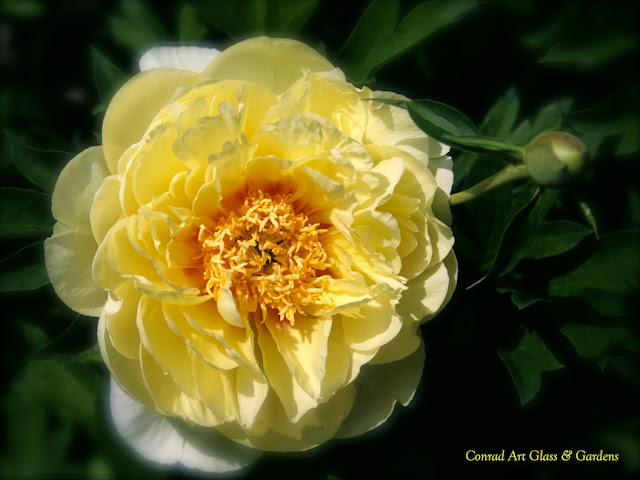It's actually getting harder to find plants in my gardens that I wouldn't plant again...
it just doesn't make sense in many cases to hold on to things that don't work for me, so many less appreciated cultivars are disposed of
as they demonstrate problematic qualities...
Hesphestos Tree Peony
Tree peonies are a highlight of this gardener's year.
I consider the blooms to be a short-lived precious garden gem.
I enjoy the lovely foliage all season.
My Hesphestos is particularly important to me since it was started as a new graft, created for me by Bill Seidl.
Tree peonies are heavy feeders... if possible, dig in aged manure in a trench at the perimeters of the plant once a season...
I simply spread aged manure on the ground since my tree peonies are entangled in the roots of Pinus strobus 'Torulosa'.
Give tree peonies a bit of shade to insure longer lasting blooms as they prefer being out of hot afternoon sun.
Were I to start over, I'd use beach umbrellas supported in PVC tubes
buried to the top vertically in the soil, thus giving the plant good sun
when not in bloom and shade when in bloom.
Enrich the soil (if sandy this is especially important)...
they need lots of nutrients
Provide neutral to slightly alkaline soil.
Provide a situation with good drainage.
Tree peonies are at least zone 4 hardy.
Do not remove old wood unless dead in spring.
(YES)
Bartzella Intersectional Peony
(Tree peony x herbaceous peony)
(Tree peony x herbaceous peony)
Everything noted above applies to Intersectional peonies with the exception
of cutting them back to healthy stem buds in the fall...
normally this will be to the 6" area on intersectionals.
Bartzella will easily reach 3' x 3'
Bloom period for a mature Bartzella can be as much as 6 weeks.
Well over a hundred 9" blooms is not unheard of on a mature Bartzella.
(YES!!!)
(Some folks get married and want lots of kids... two kids were enough for me, but I do want lots of Bartzellas. I tried dividing one this fall and found no obvious division points... I chickened out and simply moved the plant to a spot where I will be better able to appreciate it.)
of cutting them back to healthy stem buds in the fall...
normally this will be to the 6" area on intersectionals.
Bartzella will easily reach 3' x 3'
Bloom period for a mature Bartzella can be as much as 6 weeks.
Well over a hundred 9" blooms is not unheard of on a mature Bartzella.
(YES!!!)
(Some folks get married and want lots of kids... two kids were enough for me, but I do want lots of Bartzellas. I tried dividing one this fall and found no obvious division points... I chickened out and simply moved the plant to a spot where I will be better able to appreciate it.)
Fagus sylvatica 'Roseo-marginata'
('Tricolor', 'Purpurea Tricolor')
A purple leaf form of European beech with a border of rose and pinkish white
There is apparently some confusion in terms of the names listed above and they may all actually be the same plant, although tricolor supposedly has more distinct cream and pink borders to the foliage. Not worth obsessing over in my opinion.
This form of european beech has been known since 1883.
Some shade during the hottest times of the day will help to prevent leaf scorch, although
I see scorching of foliage towards the end of the season most years, as with many trees with variegated foliage.
Probably not a tree for zone 8 or warmer and can be damaged or killed
in a bad year in the midwest
(YES)
 |
| Roseo-marginata coupled with Celestial flowering dogwood |
Iris Germanica 'Stepping Out'
This is an older variety that has done well for me overall.
Two major concerns with tall bearded irises in my mind...
a. Tall bloom stalks often need staking.
b. Big concerns with iris borer in my gardens
I've never treated for borer although 'Merit' would probably do the trick.
Regarding Tall German iris... I'll keep the ones I have, but won't likely add more.
I do use intermediate iris as a substitute that doesn't require staking.
(NO)
All for today... take care, Larry













0 nhận xét:
Đăng nhận xét